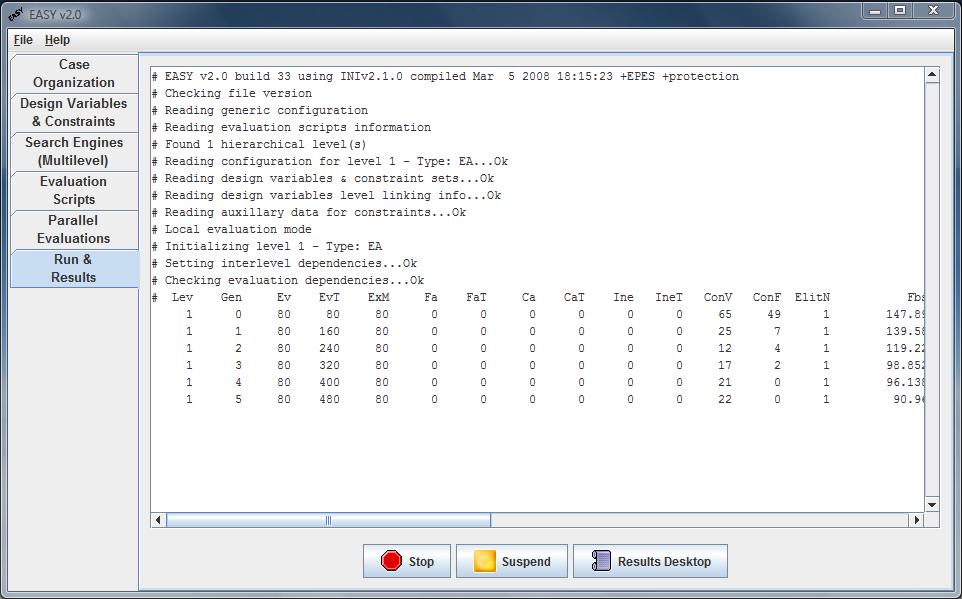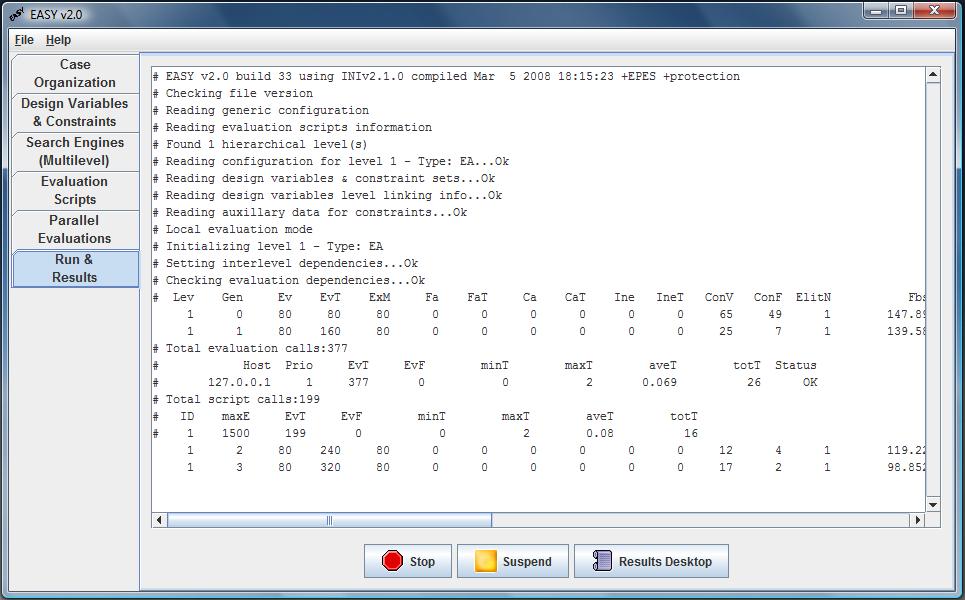Run & Results
This tab performs the optimisation run and controls the whole optimization
process. The optimisation starts by pressing the Start button, which
automatically turns to the command Stop and freezes all previous tabs.
Commands such as Stop or Suspend may be given only at the end
of every generation.
To resume a stopped optimisation, the continuation checkbox must be selected
in the Case Organization tab.
As it is mentioned in the introduction:
The current working directory is implicitly specified from the location of
the settings file opened or saved.

The main text pane displays details about the evolution. The contents
of this pane are saved to the Log file defined in the Case Organization tab.
A formatted text line is appended at the end of each generation.
Lines beginning with "#" are extra comment lines. A normal (no comment) text
line consists of 25 for SOO and 23 for MOO numerical space separated fields
The 25 numerical, space separated fields for SOO are:
# Lev Gen Ev EvT Exm Fa FaT Ca CaT InE InET ConV ConF ElitN Fbst Fmin Fmax Fave Fdev InErmin InErmax InErave InErdev Lev1Ev TotCost
where :
Lev: Level identity.
Gen: Current generation.
Ev: Number of exact (i.e. exluding metamodel-based) evaluations
performed in this generation for level Lev.
EvT: Total number of exact evaluations performed thus far for level
Lev.
Exm: Polulation size for this level.
Fa: Number of failed evaluations in this generation for level
Lev (without producing a complete task.res) in the current generation.
FaT: Total number of failed evaluations thus far for level Lev.
Ca: Number of obviated evaluations (individuals found in the DB;
no re-evaluation is needed) in this generation.
CaT: Total number of obviated evaluations for level Lev.
InE: Number of inexact evaluations carried out in this generation
(this value cannot be zero if IPE has been activated) for level Lev.
InET: Total number of inexact evaluations carried out thus far for
level Lev.
ConV: Number of individuals in this generation that violate even one
of the constraints set by the user for level Lev.
ConF: Number of individuals in this generation that 'strongly'
violate any of the constraints set and, therefore, death penalty applies to
them.
ElitN: Number of elite individuals for level Lev.
Fbst: Best objective function found so far for level Lev.
Fmin: Minimum objective function value in this generation.
Fmax: Maximum objective function value in this generation.
Fave: Average objective function value in this generation.
Fdev: Standard deviation of the objective function value in this
generation.
InErmin: Mininimum error of Metamodels (if IPE has been activated)
in this generation and level Lev.
InErmax: Maxinimum error of the Metamodel.
InErave: Average error of the Metamodel.
InErdev: Standard deviation of the error of Metamodels.
Lev1Ev: First level evaluations carried out so far; recall that,
by convention, the first level evaluations are the most expensive ones.
TotCost: Computation cost in cost units (according to definitions
in the Evaluation Scripts tab) including evaluations from all levels.
For MOO the 23 numerical, space separated fields are:
# Lev Gen Ev EvT Exm Fa FaT Ca CaT InE InET ConV ConF ElitN Eadd Erem Etr InErmin InErmax InErave InErdev Lev1Ev TotCost
where (only those not explaibed above follow) :
Eadd: Elites added in the Pareto front for this generation and
level Lev.
Erem: Elites removed from the Pareto front.
Etr: Elites trimmed from the front.
Additionally some extra information about the total number of evaluations
done since an EASY file was opened, the number of script calls and the
evolution in the different levels is shown.

|